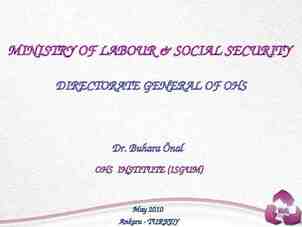NIH Mentored Career Development Awards (K Series) Part
15 Slides101.50 KB
NIH Mentored Career Development Awards (K Series) Part 2 Thomas Mitchell, MPH Department of Epidemiology & Biostatistics University of California San Francisco
Writing a competitive mentored K award grant application Main sections of the grant application The Candidate (Sections 2 – 5) Statements by Mentors, Co-Mentors, and Collaborators (Section 7; limited to 6 pages) Description of Institutional Environment (Section 8; limited to 1 page) Institutional Commitment to Candidate’s Research Career Development (Section 9: limited to 1 page) Research Plan (Sections 10 and 11)
Statements by Mentors, Co-Mentors, and Collaborators Assemble a complementary team Choose a primary mentor who is a senior investigator with a track-record of NIH funding; your primary mentor should be at UCSF. Include co-mentors who will complement the primary mentor’s strengths. Avoid including co-mentors from institutions outside the Bay Area.
Statements by Mentors, Co-Mentors, and Collaborators (Cont’d) Each member of your “team” must play a role in your training or research plan. Establish a relatively small (3-4) mentoring committee. If you need to add additional members, call them scientific or technical advisors/collaborators, who have a relatively narrow area of responsibility and focus. This section is limited to 6 pages. Each member of your team must submit a signed letter. The primary mentor’s letter should be at least 2 pages, leaving only 4 pages for all other members; hence, the total number of mentors/advisors on your team should not exceed 5.
Statements by Mentors, Co-Mentors, and Collaborators (Cont’d) Evaluation criteria for primary mentor: Appropriateness of mentor’s research qualifications in the area of this application. Quality and extent of mentor’s role in providing guidance and advice to candidate. Previous experience in fostering the development of more junior researchers. History of productivity and support. Adequacy of support for the research project.
Letters of Collaboration The letter from the primary mentor is key. It should cover the following areas: His or her qualifications in the research area proposed by the candidate. Previous experience as a research supervisor. The nature and extent of supervision that will occur during the award period. Include an evaluation component that describes how your mentors will assess your progress (e.g., quarterly meetings). Include specific milestones during the K award (e.g., completion of coursework, submission of manuscripts ). What resources, if any, they will make available to you in support of your training and/or research. See Example 1.
Letters of Collaboration (cont’d) Any of the following issues could also be addressed, which are the criteria by which the candidate will be evaluated: Potential for conducting research Evidence of originality Adequacy of scientific background Quality of research endeavors or publications to date Commitment to patient-oriented research Need for further research experience and training
Primary mentor’s letter (cont’d) The primary mentor’s letter can also “re-frame” any potential weaknesses in the application. Examples: Productivity of candidate (e.g., few publications). Feasibility of conducting research plan with resources of K award. Limited mentoring experience of primary mentor. Limited resources of primary mentor (e.g., no current R01 funding. Co-mentor(s) not at UCSF. Scientific overlap with primary mentor.
Letters of Collaboration (cont’d) Letters from co-mentors, scientific advisors, and others can be much shorter. Be sure to include description of the role of the co-mentor/scientific advisor. Make sure that letters are consistent with text in grant application (re: frequency of meetings, etc.). See Example 2.
Description of Institutional Environment This section is limited to 1 page. Evaluation criteria: Adequacy of research facilities and the availability of appropriate educational opportunities. Quality and relevance of the environment for scientific and professional development of the candidate.
Description of Institutional Environment (Cont’d) Describe the research facilities and educational opportunities of the sponsoring institution (UCSF) that are related to the candidate’s career development training and research plans. Include relevance of each component to your career development plan. Describe resources outside UCSF, as needed. See Example 3 .
Institutional Commitment to Candidate’s Research Career Development This section is limited to 1 page. Evaluation criteria Applicant institution’s commitment to the scientific development of the candidate and assurances that the institution intends the candidate to be “an integral part of its research program.” Applicant institution’s commitment to protect at least 75% of the candidate’s effort for proposed career development activities.
Institutional Commitment to Candidate’s Research Career Development (Cont’d) These assurances are stated in a letter from your department chair or division chief (see Example 4). Note: For fellows, this letter must state that you will be promoted from your current position to a “higher” position (ideally, to a full-time faculty position) during the K award period.
Letters of Recommendation 3 - 5 letters are required. They should be from senior investigators who have competed successfully for NIH funding and have been involved in the training of junior investigators. Can be from any period in your career (e.g., medical school, residency). Cannot be from your primary mentor or comentors.
Letters of Recommendation (cont’d) Letters should address the candidate’s potential for a research career. Potential for conducting research Evidence of originality Adequacy of scientific background Quality of research endeavors or publications to date Commitment to patient-oriented research Need for further research experience and training




















